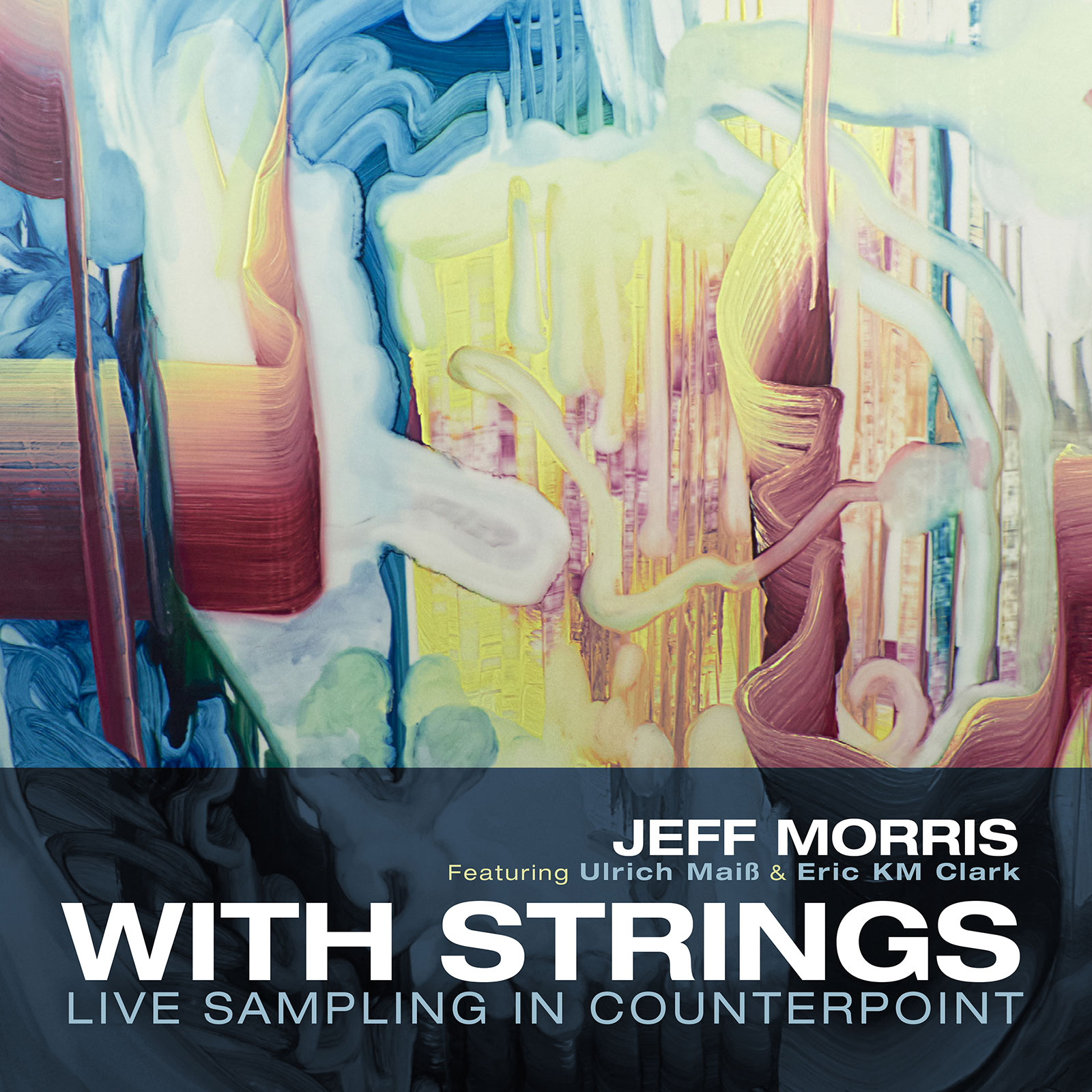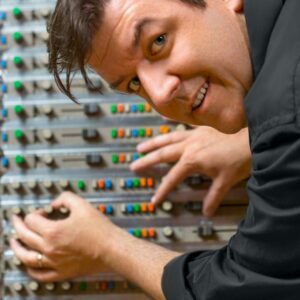
Share Album:
With Strings
Jeff Morris composer
Ulrich Maiss electric cello
Eric KM Clark violin
Jeff Morris’s second album, WITH STRINGS, explores the possibilities of 21st-century counterpoint. He builds up rich musical textures by sampling violin and cello live and folding them back into the mix, influencing the performers in turn.
German electric cellist Ulrich Maiss, a former collaborator of Lou Reed and Al Di Meola, joins Morris on B4ch1007 (“Bach Loot”). The piece is a vivid, glitchy fantasy on J. S. Bach’s music, with inspiration from Lou Reed’s classic Metal Machine Music and a video graphic score reminiscent of early experimental film by Hans Richter. Morris uses sound to visually distort the manuscript of Bach’s famous Cello Suite, yielding a new musical score to read. This audiovisual reimagining is native to our time while gleaning some underlying musical intuition from the flow of Bach’s music.
Eric KM Clark (Southland Ensemble, California E.A.R. Unit) performs a tryptich of improvised works in different interactive environments: a virtual string quintet, a tangled strand of echoes, and a microscopic journey inside the materials that make up the violin itself. Morris controls these musical constructs live, which are inspired by a house of mirrors and Einstein’s daydream of riding beside a beam of light. Using control interfaces like a gamepad and Nintendo Wii Remotes (Wiimotes), Morris takes a variety of roles in the music, ranging from a performer alongside Clark to a digital conductor of his own software orchestra.
This is not your ordinary laid-back “strings” music. Rather, it is a vibrant journey through the possibilities of digital-native chamber music that is sure to light up your imagination.
Listen
Stream/Buy
Choose your platform
Track Listing & Credits
| # | Title | Composer | Performer | |
|---|---|---|---|---|
| 01 | B4ch1007 (Bach Loot): I. 3ld3r_up | Jeff Morris | Jeff Morris, live electronics; Ulrich Maiss, electric cello | 2:11 |
| 02 | B4ch1007 (Bach Loot): II. d3m34n_4II | Jeff Morris | Jeff Morris, live electronics; Ulrich Maiss, electric cello | 4:55 |
| 03 | B4ch1007 (Bach Loot): III. n0_cur473 | Jeff Morris | Jeff Morris, live electronics; Ulrich Maiss, electric cello | 3:04 |
| 04 | B4ch1007 (Bach Loot): IV. b4d_4r3n45 | Jeff Morris | Jeff Morris, live electronics; Ulrich Maiss, electric cello | 5:08 |
| 05 | B4ch1007 (Bach Loot): V. 71n_mu53 | Jeff Morris | Jeff Morris, live electronics; Ulrich Maiss, electric cello | 3:59 |
| 06 | B4ch1007 (Bach Loot): VI. zh336 | Jeff Morris | Jeff Morris, live electronics; Ulrich Maiss, electric cello | 4:07 |
| 07 | 3 Improvisations: No. 1, Choro | Jeff Morris | Jeff Morris, live electronics; Eric KM Clark, violin | 10:18 |
| 08 | 3 Improvisations: No. 2, Echo | Jeff Morris | Jeff Morris, live electronics; Eric KM Clark, violin | 9:21 |
| 09 | 3 Improvisations: No. 3, Micro | Jeff Morris | Jeff Morris, live electronics; Eric KM Clark, violin | 7:56 |
B4ch1007
Video graphic score and live sampling improvisation software environments created by Jeff Morris
Recorded April 25–28, 2016, at Texas A&M University in College Station TX
Three improvisations with violin
Live sampling improvisation software environments created by Jeff Morris
Tracks 7–8 recorded July 3, 2005, at the Atlantic Center for the Arts in New Smyrna Beach FL
Track 9 recorded November 10, 2006, at Tulane University in New Orleans LA
Cover and package artwork
With Strings, oil on drafting film, 2018.
April Zanne Johnson www.aprilzannejohnson.com
Executive Producer Bob Lord
Executive A&R Sam Renshaw
A&R Brandon MacNeil
Vice President, Audio Production Jeff LeRoy
Production Engineer Lucas Paquette
Art Director Brett Picknell
Design Ryan Harrison, Edward A. Fleming
Publicity Scott Feldman, Patrick Niland
Artist Information

Jeff Morris
Jeff Morris creates musical experiences that engage audiences’ minds with their surroundings. His performances, installations, lectures, and writings appear in international venues known for cutting-edge arts and deep questions in the arts. He has won awards for making art emerge from unusual situations: music tailored to architecture and cityscapes, performance art for the radio, and serious concert music for toy piano, robot, Sudoku puzzles, paranormal electronic voice phenomena, and live coding using algebra and breath-controlled piano.
Ulrich Maiss
Ulrich Maiß lives in Rostock Germany. He has worked with Lou Reed, Robert Wilson, Al Di Meola, Zülfü Livaneli, Joseph “Butch” Rovan, Metallica, ChillFactor 5, Lynn Miles, Alexander Veljanov, Theodor Franck, and Element of Crime. Well-known as a performer of contemporary European chamber music, he has also performed with various rock and folk acts throughout Northern Europe, Greece, and Turkey. His solo projects in the field of experimental music led him to Japan, the United States, and Canada. He played his solo interpretation of Lou Reed’s legendary Metal Machine Music titled CelloMachine on the road for several years.
Eric KM Clark
Accomplished Canadian violinist, composer, and artist Eric KM Clark is a specialist in new and experimental music. Based in Los Angeles, Clark is a member of the Kadima String Quartet, Gurrisonic, and co-founder/co-director of Southland Ensemble. He was also a member of the genre-setting ensemble The California E.A.R. Unit for six years, which gave important performances and masterclasses on contemporary music and technique around the world. Clark has worked with many of the world’s most innovative artists and ensembles, including the late James Tenney, Jurg Frey, Michael Gordon, Richard Foreman, Guy Maddin, Christian Kesten, Michael Pisaro, Morton Subotnick, and Han Bennink.
Notes
It’s been amazing to make music with these two gifted improvisers on stringed instruments: Ulrich Maiß on electric cello and Eric KM Clark on violin. My first experiences with them drove the first part of my career!
I met Ulrich while studying at the Center for Experimental Music and Intermedia (CEMI; University of North Texas). Ulrich visited and performed his solo cello interpretation of Lou Reed’s classic Metal Machine Music (1975), praised by Reed himself. At first listen, that album may not sound like a “composition,” something where it’s possible to play a “wrong note,” but Reed confirmed that Ulrich was getting it right, down to its essence—musicianship beyond reading notes on paper! While Ulrich was visiting, I and other students improvised with him. This happened just as I was missing my musical roots as an improviser. Working only as a composer for years, I missed the feeling of making music happen in the instant, under my fingertips. That began my career in technology-based performance.
My primary musical instrument became: “I play computer.” I build and perform with my own live sampling environments (interactive software) and interfaces (using Nintendo Wii remote controllers or a gamepad). Each creation occupies a different place on the spectrum between being a composition and an instrument. In live sampling, I go in with no pre-recorded sounds, no loops, no synthesizers: just an open mic and an open ear. I grab sounds from my improvising partners live during each performance and transform them into my own musical voice, on the spot.
Here, Ulrich joins me in performing B4ch1007 (“Bach Loot”), which I composed as a silent video graphic score. That is, it’s a graphic score, which means we interpret visual shapes instead of traditional musical notation. This approach often allows a wide range of freedom for the performers to interpret it, but it can still be a deeply-structured composition. Since it’s the score (or the “sheet music”), of course it’s silent—it’s meant for musicians to play it! This graphic score is special in that it’s a video, not just a printed page.
So B4ch1007 (“Bach Loot”) is a video graphic score in six movements, drawing on Johann Sebastian Bach’s famous Cello Suite No. 1 in G Major (c. 1717). I fed images from a Bach family manuscript of the suite and a blocky computer-notated version into my own video-processing software that uses a sound input to distort and deform images. So, it was natural to play a recording of the cello suite into the software, to make the video scores. To recap: Around 1717, Bach wrote down some music, and people played it; around three centuries later, I used the sound of it to distort the image of it, and I used the video of that sound-deformed imagery as the score for a new musical work.
This is a new work; it doesn’t sound very close to Bach’s earlier composition, but hopefully it preserves some “fingerprint” from Bach’s musical imagination, deep down. After all, I do consider live sampling to be a 21st-century extension of classical imitative counterpoint (as in a round or fugue), of which Bach was a great master. Since this work owes much to Bach, but in a convoluted way, this work and its movements are named in 1337, or leetspeak, a geeky stylized form of writing that goes back in the history of the internet (and its predecessors). While the work does “loot” Bach in some ways (1007 = loot), 1007 is also the cello suite’s catalog number among Bach’s works: BWV 1007! I’ll let you decode the movement titles; they’re all punkish misreadings derived from the movement titles in Bach’s original suite. Fittingly, we also seem to be channeling Metal Machine Music in this particular performance.
The violin tracks here were recorded just before and just after Eric KM Clark joined the California E.A.R. Unit, in my first years on the Texas A&M University faculty. We met as artists in residence, both selected by Lawrence D. “Butch” Morris, and we recorded the next two tracks there. Eric inspired a new definition of virtuoso in my mind: not just someone who can play anything written down, but someone who has mastered every possible sound his instrument can make. Ulrich’s visit had turned me back on to improvisation, and Eric joined me in the most notable improvised performances of my early career, including the International Computer Music Conference and the International Society for Improvised Music.
These tracks fit together as a triptych portrait of the violinist and his instrument: first, within a busy ensemble, then alone with his memories, and then deep inside the instrument and inside its own raw sound. In Choro, Eric dances with live copies of himself, independent but coordinated in a complex choreography, ultimately finding peace in the whistling high register. Echo portrays the violin in a lonely setting, with only echoes of the past to keep him company. As more history ends up behind him, he becomes tangled in the crumpled flutter of memories. The violin dissolves into its basic elements (violin particles?) in Micro: starting inside its resonant wooden body and continuing inside the friction of bow-against-string, and beyond, into its dry, raw essence, providing an acoustic bookend to B4ch1007.
The cover art for this album was created by April Zanne Johnson, from her perceptual responses to this album.
Thanks to: Joseph “Butch” Rovan for bringing Ulrich to improvise with us at CEMI; Lawrence D. “Butch” Morris (no relation) for leading the artist residency where I met Eric; the Atlantic Center for the Arts for providing the artist residencies where I originally met and played with Eric and April; Texas A&M University’s Vice President for Research, Academy for Visual and Performing Arts, Crawley Family Faculty Fellowship, and Department of Performance Studies for making this project possible; and of course my family and friends for their support and patience as I followed my opportunities and intuition to where I am today.
— Jeff Morris
Videos
Bach1007 (Bach Loot) mvt. 1: 3ld3r_up
Bach1007 (Bach Loot) mvt. 2: d3m34n_4ll
Bach1007 (Bach Loot) mvt. 3: n0_cur473
Bach1007 (Bach Loot) mvt. 4: b4d_4r3n45
Bach1007 (Bach Loot) mvt. 4: b4d_4r3n45
Bach1007 (Bach Loot) mvt. 5: 71n_mu53
Jeff Morris with Eric KM Clark — I. Choro
Jeff Morris with Eric KM Clark — II. Echo
Jeff Morris with Eric KM Clark — III. Micro
